Evaluating TiO2 Photocatalysis Performance in Microtubes on Paper Background by Smartphone: Principles and Application Examples
Abstract
:1. Introduction
2. Experimental Part
2.1. Materials
2.2. Configuration of Mixed Dyes and Wastewater
2.3. Evaluating Photocatalytic Performance by the PMTs Method
3. Results and Discussion
3.1. Color Greyscale-Concentration Curves of Different Dyes Measured by the PMTs Method
3.2. The Measurement of the Reaction Process of Photocatalytic Degradation of Different Dyes by the PMTs Method
3.3. Measurements of the Reaction Process of Photocatalytic Degradation of SA-Fe(III) Wastewater by the PMTs Method
3.4. Application Prospect and Limitation
4. Conclusions
Supplementary Materials
Author Contributions
Funding
Institutional Review Board Statement
Informed Consent Statement
Data Availability Statement
Conflicts of Interest
References
- Fujishima, A.; Honda, K. Electrochemical Photolysis of Water at a Semiconductor Electrode. Nature 1972, 238, 37–38. [Google Scholar] [CrossRef]
- Chong, M.N.; Jin, B.; Chow, C.; Saint, C. Recent developments in photocatalytic water treatment technology: A review. Water Res. 2010, 44, 2997–3027. [Google Scholar] [CrossRef] [PubMed]
- Kaljurand, M. Paper microzones as a route to greener analytical chemistry. Curr. Opin. Green Sustain. Chem. 2019, 19, 15–18. [Google Scholar] [CrossRef]
- Cate, D.M.; Dungchai, W.; Cunningham, J.C.; Volckens, J.; Henry, C.S. Simple, distance-based measurement for paper analytical devices. Lab Chip 2013, 13, 2397–2404. [Google Scholar] [CrossRef] [PubMed]
- Fiedoruk-Pogrebniak, M.; Granica, M.; Koncki, R. Compact detectors made of paired LEDs for photometric and fluorometric measurements on paper. Talanta 2018, 178, 31–36. [Google Scholar] [CrossRef] [PubMed]
- Martinez, A.W.; Phillips, S.T.; Whitesides, G.M.; Carrilho, E. Diagnostics for the developing world: Microfluidic paper-based analytical devices. Anal. Chem. 2010, 82, 3–10. [Google Scholar] [CrossRef] [PubMed]
- Scala-Benuzzi, M.L.; Raba, J.; Soler-Illia, G.J.; Schneider, R.J.; Messina, G.A. Novel electrochemical paper-based immunocapture assay for the quantitative determination of ethinylestradiol in water samples. Anal. Chem. 2018, 90, 4104–4111. [Google Scholar] [CrossRef] [Green Version]
- Dhavamani, J.; Mujawar, L.H.; El-Shahawi, M.S. Hand drawn paper-based optical assay plate for rapid and trace level determination of Ag+ in water. Sens. Actuators B Chem. 2018, 258, 321–330. [Google Scholar] [CrossRef]
- Zhang, D.; Wang, Y.; Li, C.; Zhang, X. Polychlorinated biphenyl detection in organic solvents with paper-based analytical devices. Environ. Technol. 2021, 42, 1766–1771. [Google Scholar] [CrossRef]
- Liu, X.; Tao, X.; Xu, C.; Li, X.; Chen, R.; Chen, Y.; Wang, X. Evaluation of the photocatalytic performance of molecularly imprinted S-TiO2 by paper microzones. Environ. Res. 2021, 199, 111258. [Google Scholar] [CrossRef] [PubMed]
- Gennetten, K.D. RGB to CMYK conversion using 3D barycentric interpolation. In Device-Independent Color Imaging and Imaging Systems Integration; International Society for Optics and Photonics: Washington, WA, USA, 1993; Volume 1909, pp. 116–126. [Google Scholar]
- Güneş, A.; Kalkan, H.; Durmuş, E. Optimizing the color-to-grayscale conversion for image classification. Signal Image Video Process. 2015, 10, 853–860. [Google Scholar] [CrossRef]
- Pramanik, A.; Sarkar, S.; Maiti, J. Oil spill detection using image processing technique: An occupational safety perspective of a steel plant. In Emerging Technologies in Data Mining and Information Security; Springer: Singapore, 2019; pp. 247–257. [Google Scholar]
- Nogueira, S.A.; Sousa, L.R.; Silva, N.K.L.; Rodrigues, P.H.F.; Coltro, W.K.T. Monitoring Acid–Base Titrations on Wax Printed Paper Microzones Using a Smartphone. Micromachines 2017, 8, 139. [Google Scholar] [CrossRef] [Green Version]
- Moreira, C.M.; Marín-Barroso, E.; Pereira, S.V.; Raba, J.; Messina, G.A.; Bertolino, F.A. A nanostructured paper-based device for phenylalanine neonatal screening by LED-induced fluorescence. Anal. Methods 2020, 12, 1624–1630. [Google Scholar] [CrossRef]
- Moonrungsee, N.; Pencharee, S.; Jakmunee, J. Colorimetric analyzer based on mobile phone camera for determination of available phosphorus in soil. Talanta 2015, 136, 204–209. [Google Scholar] [CrossRef]
- Delaney, J.L.; Doeven, E.H.; Harsant, A.J.; Hogan, C.F. Use of a mobile phone for potentiostatic control with low cost paper-based microfluidic sensors. Anal. Chim. Acta 2013, 790, 56–60. [Google Scholar] [CrossRef]
- Rodriguez, M. A graphic arts perspective on RGB-to-CMYK conversion. In Proceedings of the International Conference on Image Processing, Washington, DC, USA, 23–26 October 1995; Volume 2, pp. 319–322. [Google Scholar]
- Ibraheem, N.A.; Hasan, M.M.; Khan, R.Z.; Mishra, P.K. Understanding color models: A review. ARPN J. Sci. Technol. 2012, 2, 265–275. [Google Scholar]
- Ganesan, P.; Rajini, V. Assessment of satellite image segmentation in RGB and HSV color space using image quality measures. In Proceedings of the 2014 International conference on advances in electrical engineering (ICAEE), Vellore, India, 9–11 January 2014; pp. 1–5. [Google Scholar]
- Ong, P.M.B.; Punzalan, E.R. Comparative analysis of RGB and HSV color models in extracting color features of green dye solutions. In Proceedings of the DLSU Research Congress, Manila, Philippines, 6–8 March 2014. [Google Scholar]
- Almquist, C.B.; Biswas, P. The photo-oxidation of cyclohexane on titanium dioxide: An investigation of competitive adsorption and its effects on product formation and selectivity. Appl. Catal. A Gen. 2001, 214, 259–271. [Google Scholar] [CrossRef]
- Liu, H.; Zhang, J.; Cao, C.; Zhang, S. Titanium dioxide as photocatalyst on porous nickel: Adsorption and the photocatalytic degradation of sulfosalicylic acid. Chemosphere 1999, 38, 283–292. [Google Scholar] [CrossRef]
- Zhu, L.; Liu, X.; Wang, X.; Meng, X. Evaluation of photocatalytic selectivity of Ag/Zn modified molecularly imprinted TiO2 by multiwavelength measurement. Sci. Total Environ. 2019, 703, 134732. [Google Scholar] [CrossRef]
- Liu, X.; Zhu, L.; Wang, X.; Meng, X. Photocatalytic Degradation of Wastewater by Molecularly Imprinted Ag2S-TiO2 with High-selectively. Sci. Rep. 2020, 10, 1192. [Google Scholar] [CrossRef] [PubMed] [Green Version]
- Liu, X.; Zhu, L.; Wang, X.; Meng, X. One-step synthesis of Ag2S-TiO2 and its photocatalytic degradation of ethyl paraben wastewater. Environ. Sci. Pollut. Res. 2020, 27, 13590–13598. [Google Scholar] [CrossRef] [PubMed]
- Liu, X.; Zhu, L.; Wang, X.; Meng, X.; Zhong, L. The photocatalytic selectivity between molecularly imprinted TiO2 and target contaminants. J. Nanopart. Res. 2020, 22, 1–12. [Google Scholar] [CrossRef]
- Xie, S.; Shao, W.; Zhan, H.; Wang, Z.; Ge, C.; Li, Q.; Fu, W. Cu (II)-EDTA removal by a two-step Fe(0) electrocoagulation in near natural water: Sequent transformation and oxidation of EDTA complexes. J. Hazard. Mater. 2020, 392, 122473. [Google Scholar] [CrossRef] [PubMed]
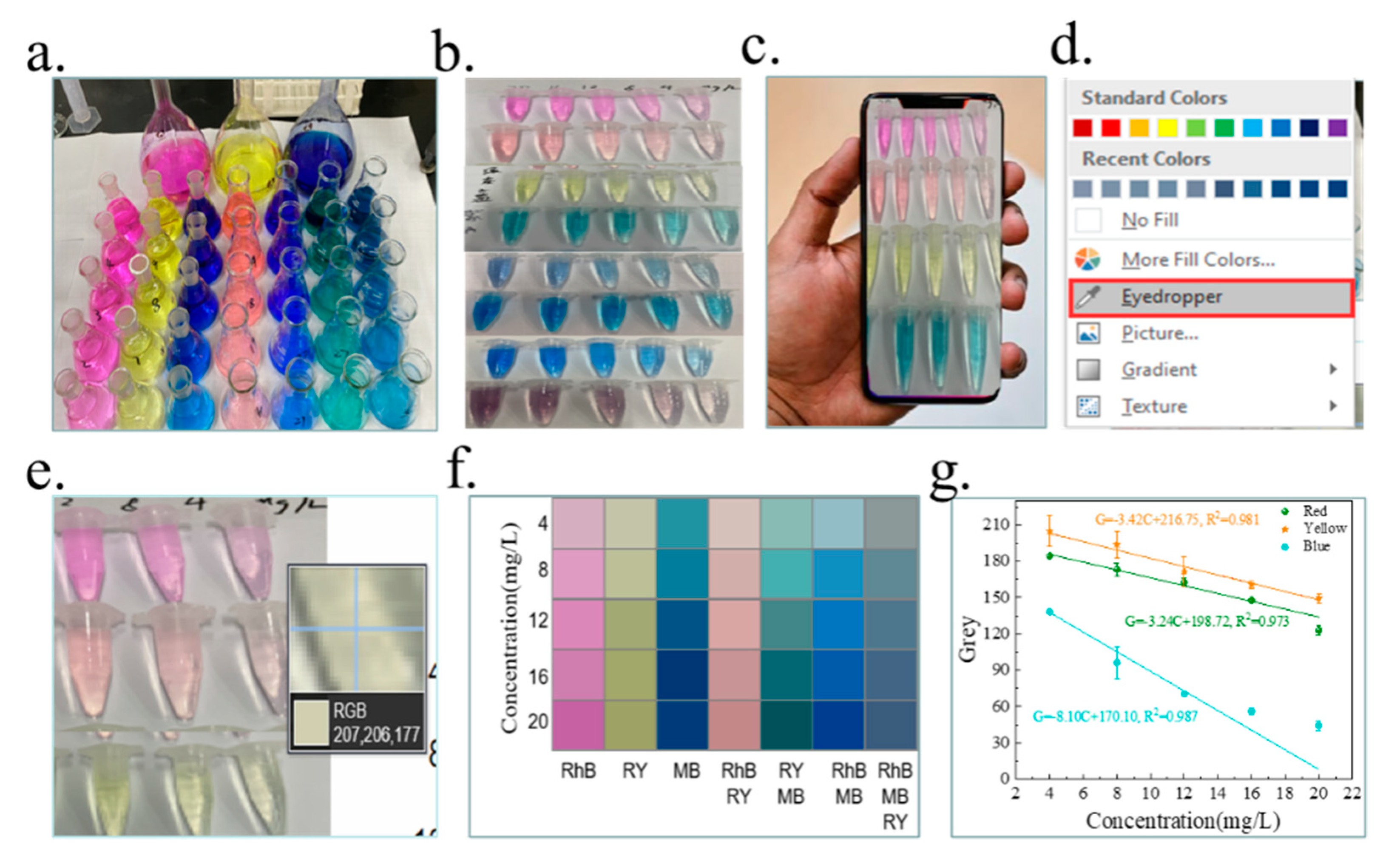
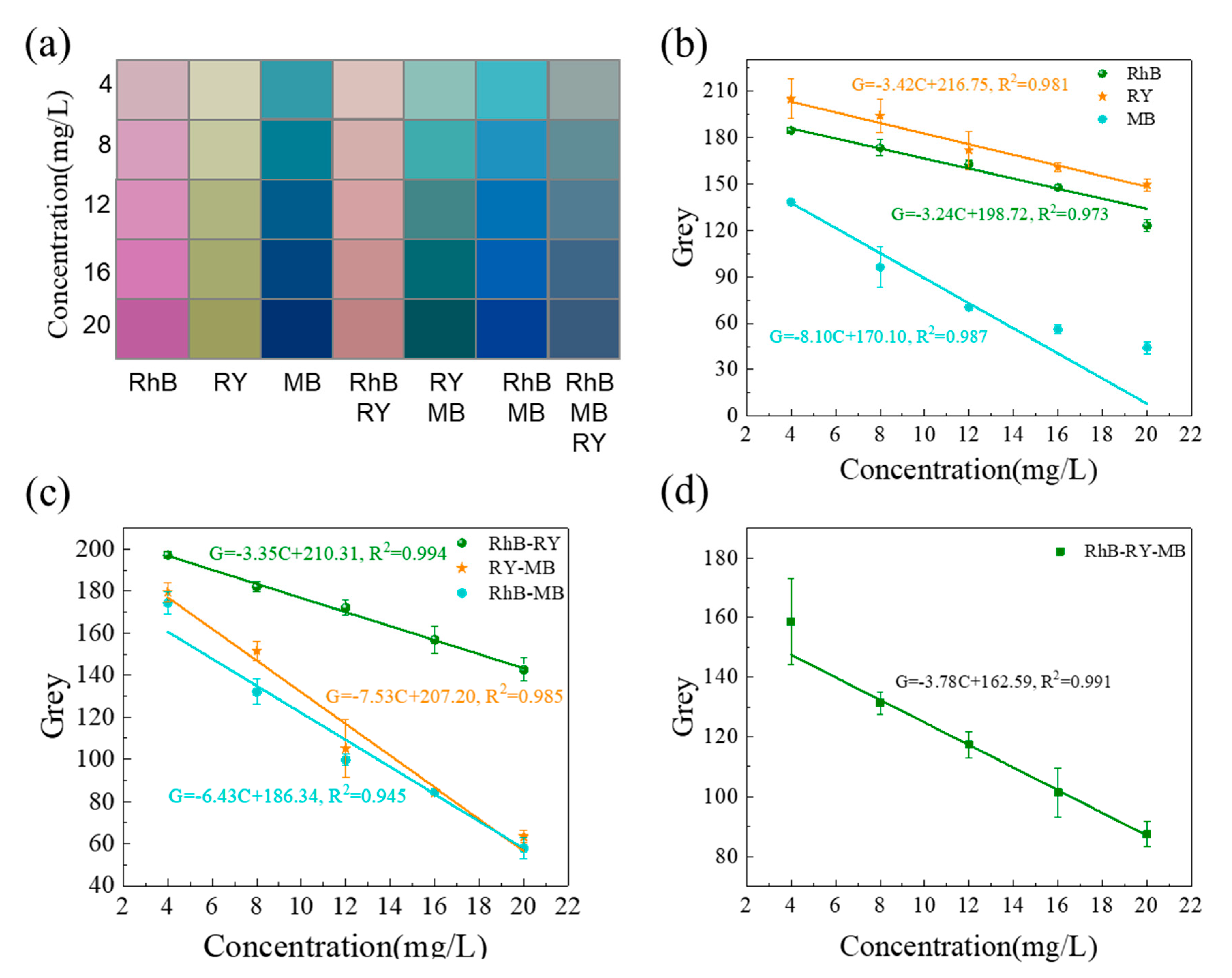
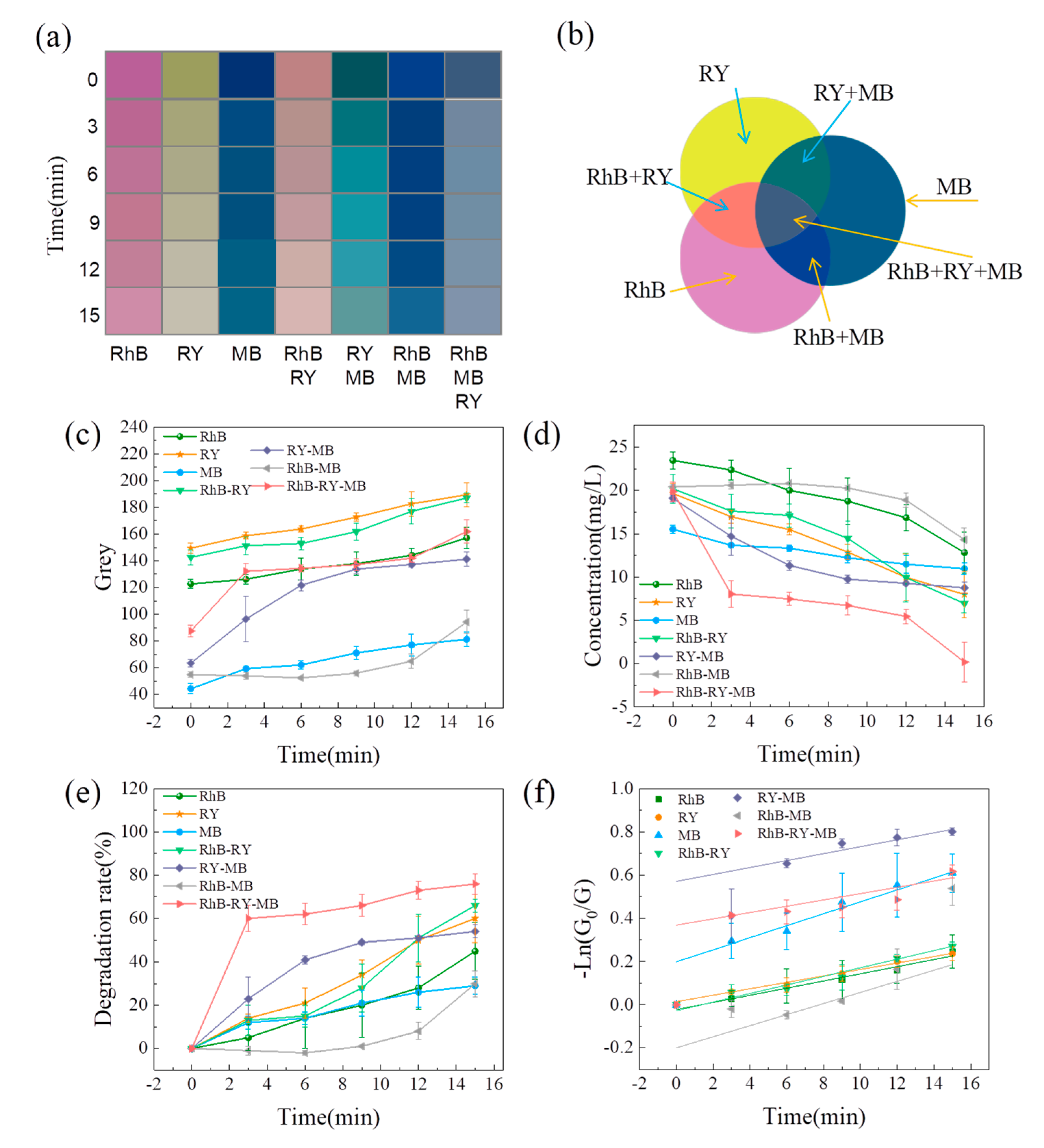
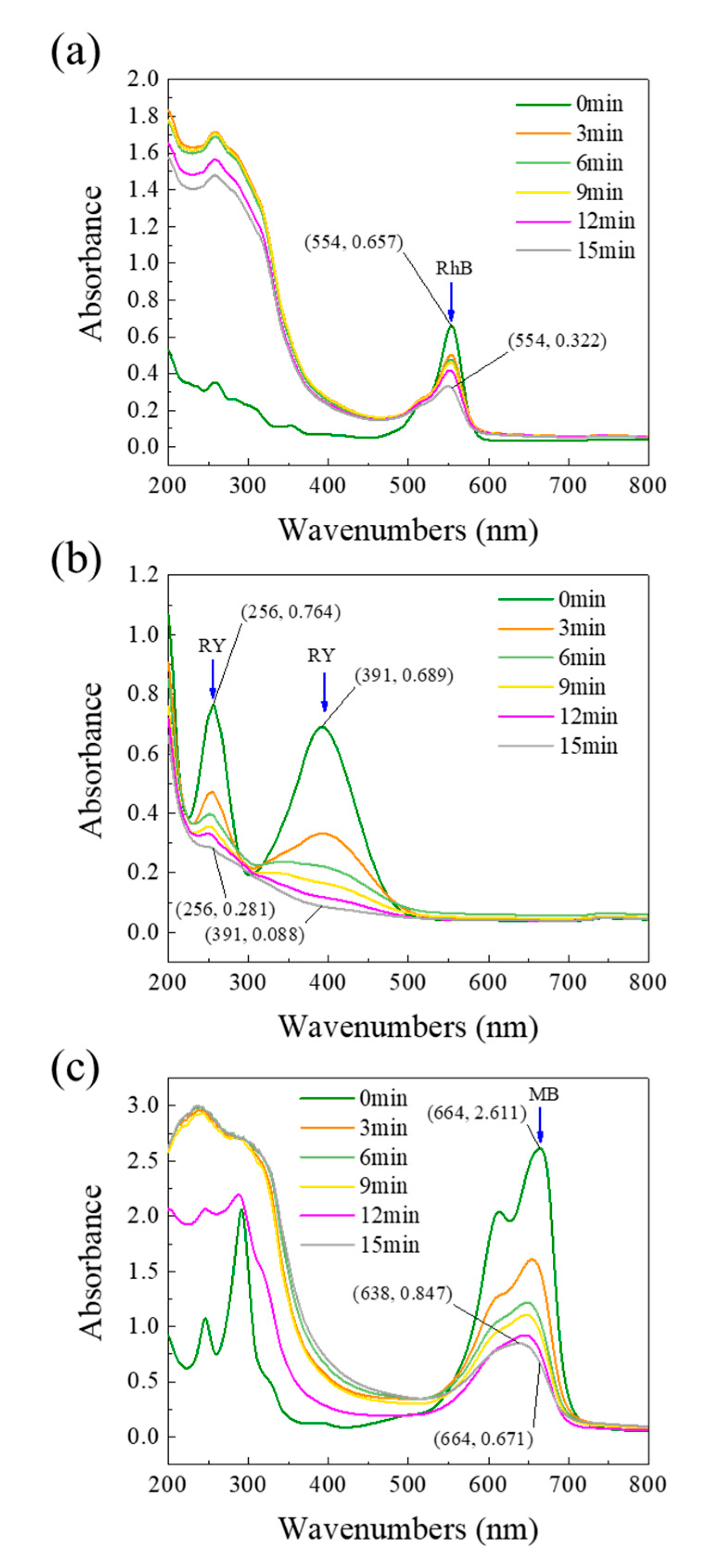
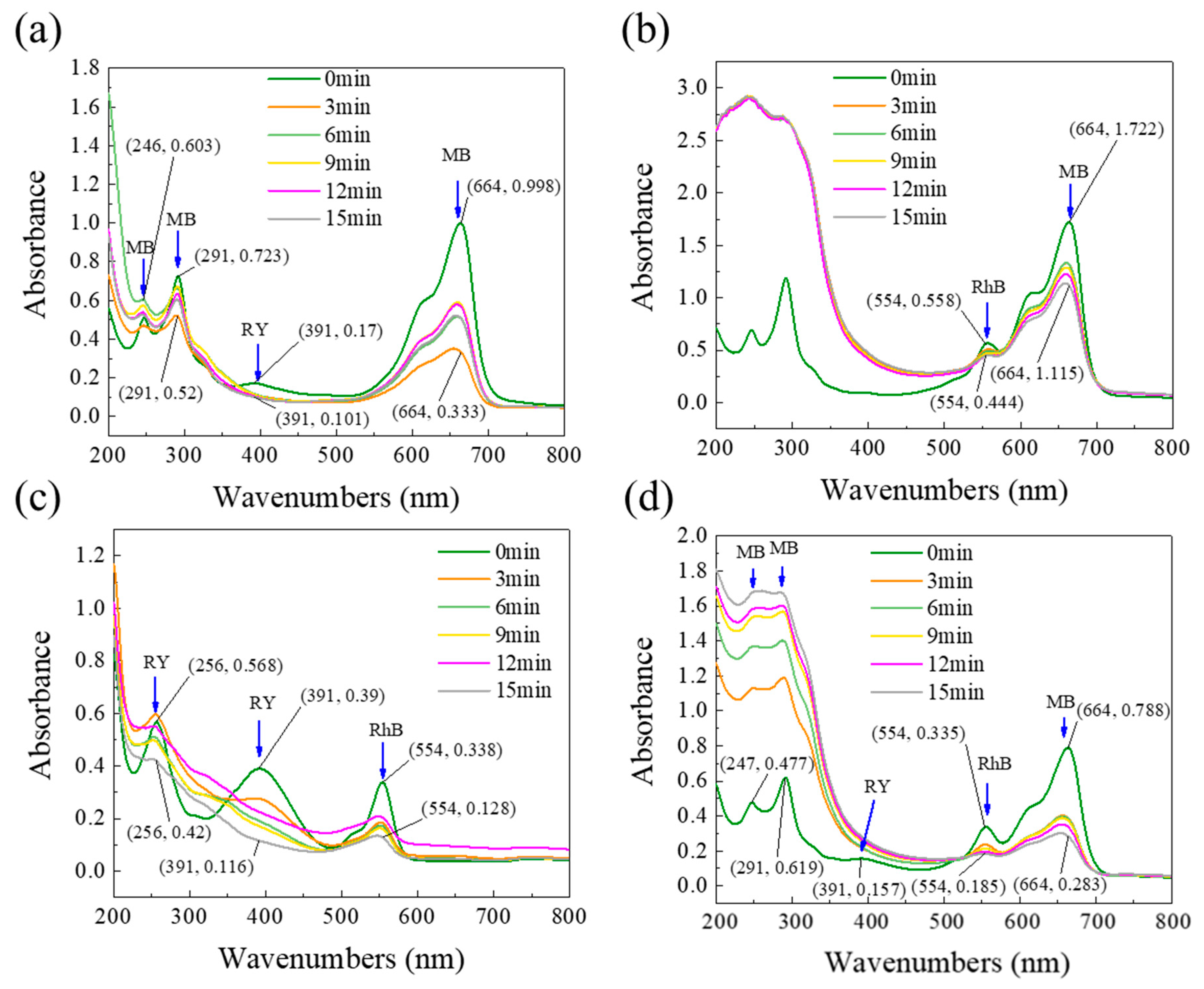
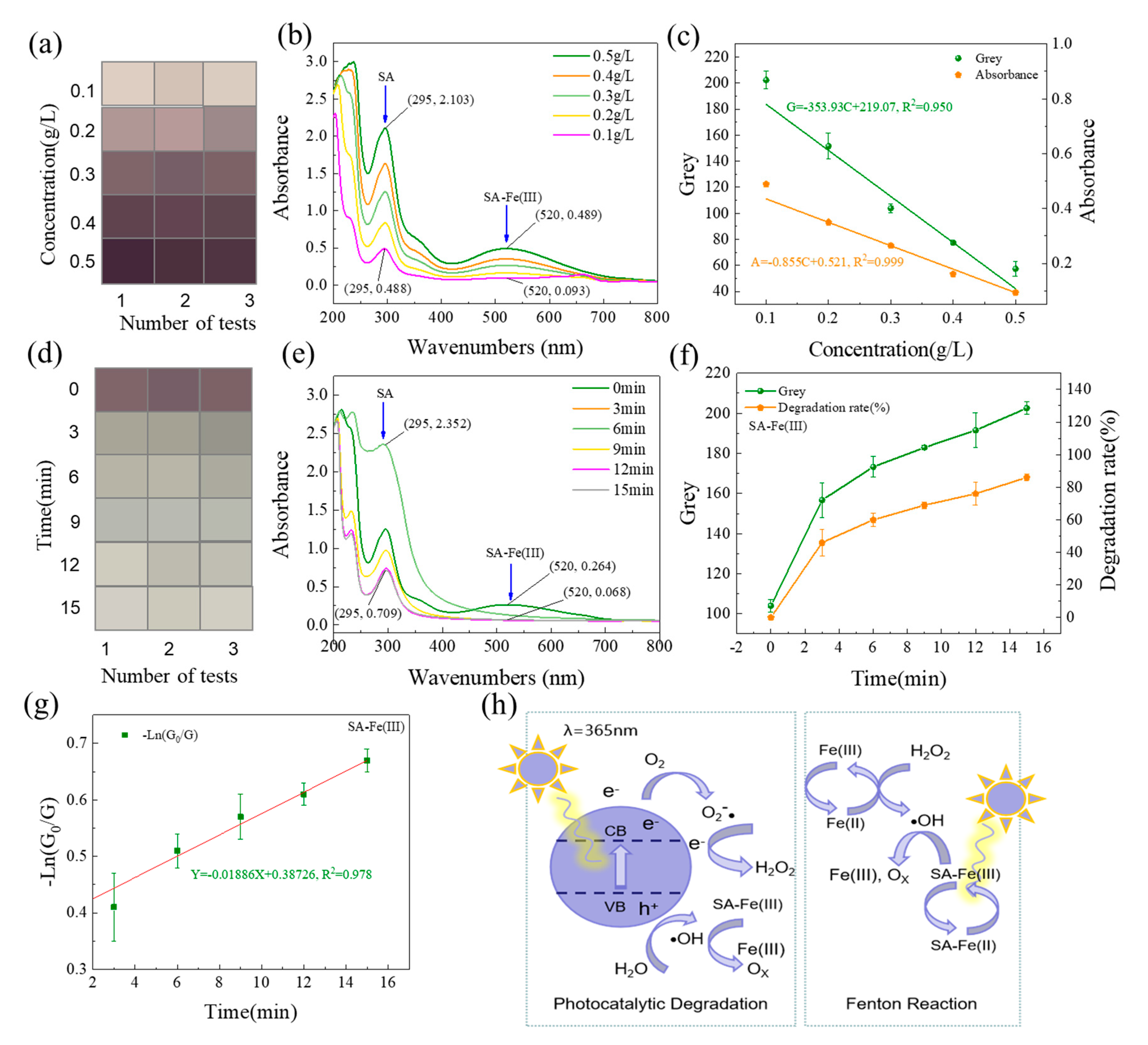

| No. | Given Name | Configuration Of Mixed Solutions | The Actual Color Description | ||
|---|---|---|---|---|---|
| Rhodamine B (20 mg/L) | Reactive Yellow (20 mg/L) | Methylene Blue (20 mg/L) | |||
| 1 | RhB | 300 mL | 0 mL | 0 mL | Pink |
| 2 | RY | 0 mL | 300 mL | 0 mL | Yellow |
| 3 | MB | 0 mL | 0 mL | 300 mL | Blue |
| 4 | RhB-RY | 150 mL | 150 mL | 0 mL | Orange |
| 5 | RY-MB | 0 mL | 150 mL | 150 mL | Green |
| 6 | RhB-MB | 150 mL | 0 mL | 150 mL | Blue purple |
| 7 | RhB-RY-MB | 100 mL | 100 mL | 100 mL | Grey blue |
| No. | Dyes (20 mg/L) | Kinetic Equations | K | R2 |
|---|---|---|---|---|
| 1 | RhB | y = 0.01658 × x − 0.02223 | 0.017 | 0.980 |
| 2 | RY | y = 0.01494 × x + 0.01445 | 0.015 | 0.995 |
| 3 | MB | y = 0.02764 × x + 0.19926 | 0.028 | 0.976 |
| 4 | RhB-RY | y = 0.0199 × x − 0.02739 | 0.020 | 0.973 |
| 5 | RY-MB | y = 0.01607 × x + 0.57049 | 0.016 | 0.837 |
| 6 | RhB-MB | y = 0.0315 × x − 0.1272 | 0.032 | 0.629 |
| 7 | RhB-RY-MB | y = 0.01461 × x + 0.36768 | 0.015 | 0.911 |
| No. | Dyes (20 mg/L) | Methods | Degradation Rates In 15 Min | Percentage | Total Degradation Rates | Reliability (Dpmts/Dabs) * |
|---|---|---|---|---|---|---|
| 1 | RhB | PMTs | 44.97% | 100% | 44.97% | 88.19% |
| Abs(554 nm) | 50.99% | 100% | 50.99% | |||
| 2 | RY | PMTs | 59.69% | 100% | 59.69% | 68.43% |
| Abs(391 nm) | 87.23% | 100% | 87.23% | |||
| 3 | MB | PMTs | 29.39% | 100% | 29.39% | 39.56% |
| Abs(664 nm) | 74.30% | 100% | 74.30% | |||
| 4 | RhB-RY | PMTs | 65.77% | 100% | 65.77% | 99.36% |
| Abs(554 nm) | 62.13% | 50% | 66.19% | |||
| Abs(391 nm) | 70.26% | 50% | ||||
| 5 | RY-MB | PMTs | 54.17% | 100% | 54.17% | 120.66% |
| Abs(391 nm) | 40.59% | 50% | 44.89% | |||
| Abs(664 nm) | 49.20% | 50% | ||||
| 6 | RhB-MB | PMTs | 30.01% | 100% | 30.01% | 107.79% |
| Abs(554 nm) | 20.43% | 50% | 27.84% | |||
| Abs(664 nm) | 35.25% | 50% | ||||
| 7 | RhB-RY-MB | PMTs | 75.93% | 100% | 75.93% | 109.07% |
| Abs(554 nm) | 44.78% | 33.33% | 69.61% | |||
| Abs(391 nm) | 100.00% | 33.33% | ||||
| Abs(664 nm) | 64.09% | 33.33% |
Publisher’s Note: MDPI stays neutral with regard to jurisdictional claims in published maps and institutional affiliations. |
© 2021 by the authors. Licensee MDPI, Basel, Switzerland. This article is an open access article distributed under the terms and conditions of the Creative Commons Attribution (CC BY) license (https://creativecommons.org/licenses/by/4.0/).
Share and Cite
Liu, X.; Xu, C.; Xie, S.; Zhu, L.; Wang, X. Evaluating TiO2 Photocatalysis Performance in Microtubes on Paper Background by Smartphone: Principles and Application Examples. Chemosensors 2021, 9, 235. https://doi.org/10.3390/chemosensors9080235
Liu X, Xu C, Xie S, Zhu L, Wang X. Evaluating TiO2 Photocatalysis Performance in Microtubes on Paper Background by Smartphone: Principles and Application Examples. Chemosensors. 2021; 9(8):235. https://doi.org/10.3390/chemosensors9080235
Chicago/Turabian StyleLiu, Xian, Chengxiang Xu, Shiwei Xie, Lei Zhu, and Xun Wang. 2021. "Evaluating TiO2 Photocatalysis Performance in Microtubes on Paper Background by Smartphone: Principles and Application Examples" Chemosensors 9, no. 8: 235. https://doi.org/10.3390/chemosensors9080235







